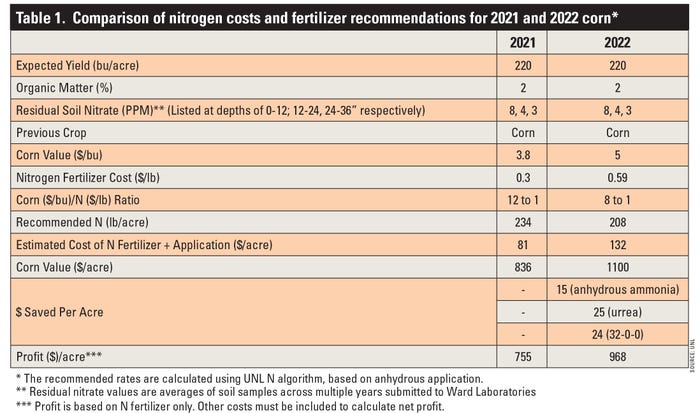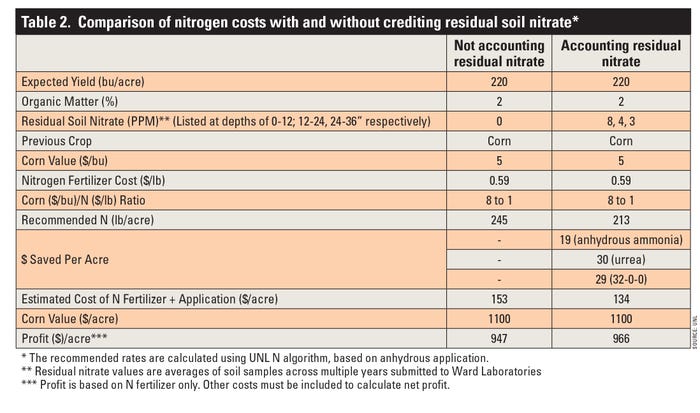November 8, 2021

With the recent increase in fertilizer prices, it is more important than ever to use the right amount of fertilizer to maximize the economic returns. Applying too little or too much fertilizer can result in substantial economic loss.
Nutrients carry over
Unused fertilizer typically carries over from the previous year, depending upon the previous year’s weather patterns, soil texture, rate of organic matter mineralization, crop nitrogen uptake and crop yield.
Most of Nebraska was drier than normal during the 2021 growing season. This may have limited downward movement of nitrate nitrogen (nitrate-N) in the soil profile, resulting in less nitrate leaching loss while also potentially reducing crop nitrogen uptake and crop yield, particularly for rainfed crops.
If you were in an area of the state with drier conditions, the residual soil N may be higher than normal for rainfed crops. Therefore, it is a profitable and environmentally sound practice to credit this residual soil nitrate-N in determining fertilizer-N rates for 2022. To credit residual nitrate-N, soil-sampling to a 2- or 3-foot depth during fall or spring will help determine the amount of residual nitrate-N.
The timing of soil sampling for making N recommendations could be important as snowmelt and precipitation during early spring may affect N losses (especially for coarse-textured soils), resulting in underapplication of preplant or in-season N. Collecting preplant soil nitrate-N soil samples is a good practice for determining residual soil nitrate-N to be credited in N-rate decisions.
High fertilizer cost
Recently, due to various global factors, fertilizer prices have rapidly increased and almost doubled compared to last year. Currently, N costs $0.58 per pound to $0.95 per pound, compared to last year’s price of $0.30 per pound to $0.38 per pound.
Corn prices have increased too, but not as much as fertilizer prices. As of late October, corn was selling around $5 per bushel for harvest 2022 deliver, while a year ago, harvest 2021 corn was trading at about $3.80 per bushel.
Commodity prices will continue to fluctuate between now and 2022 harvest. The worst place to end up is with buying high-priced fertilizer while receiving a low price for your crop — i.e., the price-cost squeeze. We strongly recommend forward-contracting a portion of your crop when buying fertilizer. Having some expected production contracted at current price levels ties you into a stronger farm average price, if prices begin to decline.
New recommendations
With the high fertilizer cost compared to last year, the relative cost of accurate fertilizer recommendations based on soil tests is less than the previous years. Assuming the same soil test costs and expected yield for 2021 vs. 2022 crops, University of Nebraska-Lincoln recommends a lower N application rate for the 2022 growing season due to the change in the fertilizer price ratio (see Table 1).
With a lower fertilizer price ratio of 8 to 1 for 2022 corn compared to the fertilizer price ratio of 12 to 1 for last year, the recommended application rate is 23 pounds per acre lower, resulting in a fertilizer savings of $14 to $22 per acre, depending on fertilizer source (see Table 1).

Additionally, by incorporating residual nitrate-nitrogen into the nitrogen fertilizer prescription, there is potential to substantially reduce fertilizer cost per acre. By accounting for residual nitrate-nitrogen in the N fertilizer prescription, growers can save $19 to $30 per acre by crediting 32 pounds of N per acre (see Table 2).
Note that the UNL calculator factors in a default soil nitrate credit even if no soil test is included. Nevertheless, we recommend using soil nitrate test values for an accurate nitrogen fertilizer prescription.

Another important factor to consider when determining optimal fertilizer rates is proper crediting for other nutrient sources, such as legumes, manure and irrigation water. If fertilizer prices have doubled compared to last year, so has the value of credits from these sources.
In the example above, the previous crop was corn. If the previous crop had been soybeans, the standard N credit for corn following soybean on a heavy textured soil would be 45 pounds per acre with potential savings of $26 to $43 per acre, depending on fertilizer source.
The cost to collect and analyze water samples for nitrate content — or manure samples for a range of nutrients — has not changed much, while the value of the nutrients these resources contain has gone up substantially.
Timing of N fertilizer application can also have a high economic impact under high fertilizer prices. Compared to fall fertilizer application, in-season fertilizer management with variable-rate technology is expected to have higher economic returns.
Bottom line
With high fertilizer prices, the fertilizer investment for the 2022 crop can be intimidating. However, with current crop prices, such investments can be profitable. It is critical, though, that investments be made with the best information possible, based on careful soil testing, and after accounting for all sources of nutrients. For more information, visit cropwatch.unl.edu.
Iqbal is Nebraska Extension nutrient management and water quality specialist. Nygren is Nebraska Extension educator. Walters is Nebraska Extension grain economist. Puntel is Nebraska Extension soil fertility and precision ag specialist. Maharjan is Nebraska Extension soil and nutrient management specialist. McClure is Nebraska Extension farm and ranch management analyst.
Source: UNL CropWatch, which is solely responsible for the information provided and is wholly owned by the sources. Informa Business Media and all its subsidiaries are not responsible for any of the content contained in this information asset.
You May Also Like




